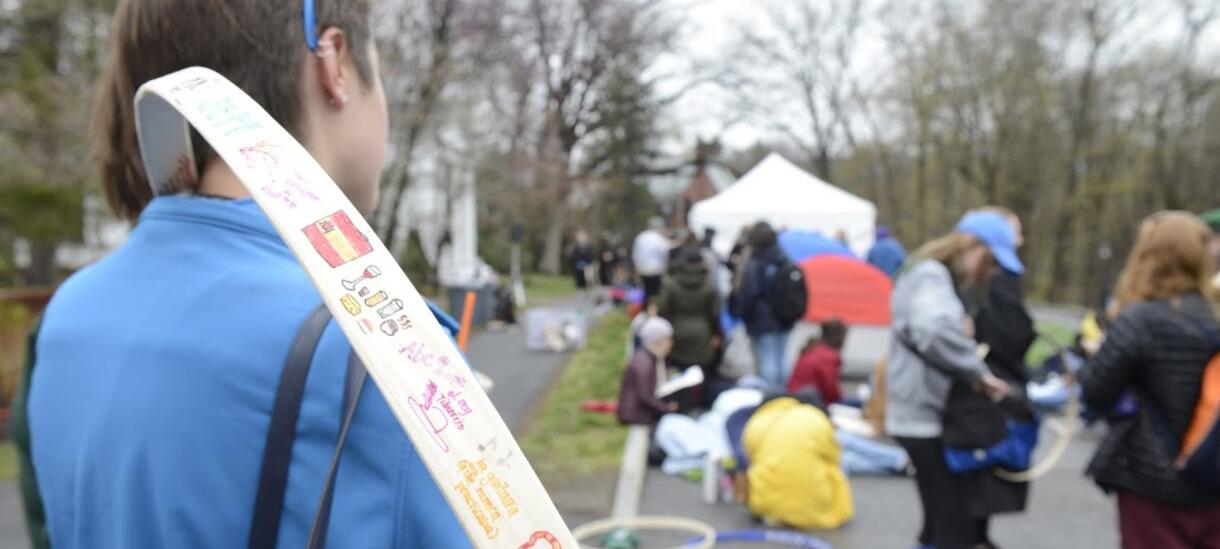
The many Wellesley-specific traditions make commencement a momentous event for students and their guests.
Traditions have helped define the "Wellesley experience" since the last century.
In recent decades, however, traditions have assumed an even greater significance. Wellesley is a vastly different place than it was when many of these traditions were first celebrated, encompassing a diversity of cultures, backgrounds, and viewpoints unknown to the generations of women here before us. In transcending these differences, our traditions are one of the major bonds uniting us and shaping our common identity, spirit, and pride as Wellesley women.
Hoop Rolling takes place at Tupelo Lane. Back in the day, it was proclaimed that whoever won the Hoop Roll would be the first to get married. In the status-seeking 1980s, she was the first to be CEO. Now we just say that the winner will be the first to achieve happiness and success, whatever that means to her. The winner is carried away by her Wellesley classmates......and has the honor of being thrown into Lake Waban. View more information about Hoop Rolling here.
Held the day before Commencement each year, the Baccalaureate service is a multifaith, spiritual gathering for graduating seniors to celebrate their journey through Wellesley College. The program includes student reflections, dancing, drumming, singing and lots of shared memories. Inspired by Wellesley's historic belief that education is a spiritual as well as an intellectual journey, Baccalaureate celebrates and affirms the diversity of religious and cultural identities of our students, as a part of the student experience.
The procession will form at 1:40 p.m. on the path between Founders Hall and the Margaret Clapp Library if the weather is fair, or under the tent on Severance Green if rain. As seating is limited in the Chapel, Each graduating seniors will receive one ticket for Baccalaureate for a family member to attend in person. Additional viewing for families will be located at the Library Lecture Room.
There will be a special Baccalaureate concert at 8PM.
The Commencement Procession is one of the few remaining occasions for which the faculty of American colleges and universities still wear formal regalia. Participants in Wellesley's Commencement Procession reflect the colors, chevrons, velvets, and wools of diverse degrees earned here and abroad.
Perhaps the most readily identified of American regalia is the crimson robe bedecked with three black velvet stripes on the sleeve, denoting the doctoral degree of Harvard University. Although most American universities observe the traditional black robe, distinguishing among levels of education by the cut of the robe and the colors on the hood trim, Harvard is one of a number of institutions permitting colored robes (others include Yale, Brown, Boston, and Johns Hopkins Universities).
Most gowns reflect degrees earned in the United States and are prescribed by the American Council of Education; the present form was adopted in 1932 and revised in 1959.
According to this form, observed by most members of the Wellesley College faculty as degree recipients from American universities, the bachelor's gown is plain with long pointed sleeves. The master's gown is slightly fuller in cut and has long oblong sleeves open at the wrist with an arc cut in the front. The doctor's gown is still fuller with bell shaped sleeves. It is faced down the front with black velvet and has three bars of black velvet on the sleeve, although the velvet and bars may be in the color representing the bearer's academic field, as in the British system.
Hoods are the most distinctive part of the American academic dress. The exterior of the hood is black, its length is three feet for the bachelor's degree, three and one-half feet for the master's degree, and four feet for the doctor's degree. Hoods are lined with the official colors of the college or university conferring the degree, and the trimming is velvet, reflecting the color of the bearer's academic field.
For all academic purposes, including trimming of the doctor's gown and edging of hoods, the color indicating the Fields of Learning are: Art, Letters, Humanities - White; Economics - Copper; Education - Light Blue; Fine Arts - Brown; Music - Pink; Philosophy - Dark Blue; Physical Education - Sage Green; Science - Golden Yellow; Theology - Scarlet.
"America The Beautiful" was written by Katharine Lee Bates, Wellesley Class of 1880, in its original form in the summer of 1893 after a trip to Colorado Springs. It first appeared in print in The Congregationalist two years later, and within a few months Silas G. Pratt set it to music. In 1904, after receiving many requests for use in publications and special services, Katharine Lee Bates rewrote it to simplify the text. She made one additional change in the wording of the third stanza a few years later, to give us the version we know today.
Over sixty original musical settings, some by distinguished musicians, have been written for the hymn. The music by S.A. Ward became the most widely accepted version and is the one still used today.
Amazed by its immediate and lasting success, Katharine Lee Bates wrote: “That the hymn has gained, in these twenty odd years, such a hold as it has upon our people, is clearly due to the fact that Americans are at heart idealists, with a fundamental faith in human brotherhood.”
Wellesley’s tradition of academic excellence has always included a world-class faculty intent on intellectually rigorous and energetic engagement in and beyond the classroom. Wellesley offers a number of programs, grants, and awards designed to encourage the art of teaching and enhance the academic experience. The Pinanski Teaching Prizes are announced at the commencement ceremony.
